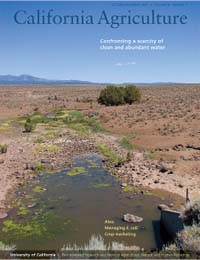All Issues
Letters
Publication Information
California Agriculture 62(1):5-6.
Published January 01, 2008
PDF | Citation | Permissions
Full text
Ag info network needs funds
The topic of water research, as reported in California Agriculture (October-December 2007), points out a persistent theme of land-grant university scientists: Once initial studies of a subject have been undertaken, there is a need for extended research, including fieldwork, to solve important questions. For instance, harmless E. coli is used as an indicator of pathogens in water supplies — but the critical questions concerning the load and concentration of actual pathogens in water bodies, and their response to management practices and wetlands, are unanswered (page 159). A separate article on juniper removal also refers to “substantial data and research gaps in our knowledge” of the influence of western juniper on hydrology (page 166).
The resolution of such issues as the long-term health of our citizens and the continuation of problems in the environment depends on well-integrated agricultural and environmental research. However, federal support for such research has been steadily decreasing, at the same time that funding for health research, development and dissemination has increased exponentially.
It is critical for scientists, educators, extension agents and agribusiness leaders to build a coherent and responsive system serving all communities. They need resources for research in the public interest, and that research must be available. Increasingly that means “discoverable” on the Internet.
The National Agricultural Library, land-grant universities and related organizations are designing a digital library that will support dynamic, collaborative and fully integrated electronic agricultural information systems. However, planning for the Digital Library for Agriculture has been hampered due to the lack of funds, which have basically been static since 1985.
USAIN, the United States Agricultural Information Network, (representing 40 states and five countries) has recently advocated for adequate funding through the Farm Bill, which is still pending approval in Congress ( http://www.usain.org ).
Norma Kobzina, President, USAIN 2007–2008
Head, Information Services
UC Berkeley Bioscience and Natural Resources Library
Cause of Klamath fish die-offs disputed
An incorrect statement was made concerning the cause of fish die-offs (attributed to Levy [2003]) in the juniper removal article in California Agriculture (October-December 2007). The National Research Council (NRC) is the operating arm of the National Academy of Sciences (NAS) and the National Academy of Engineering (NAE). An NRC committee spent almost 2 years reviewing agency decisions surrounding the Klamath water situation (see Endangered and Threatened Fishes in the Klamath River Basin: Causes of Decline and Strategies for Recovery, National Academies Press, 2004). William Lewis of the University of Colorado testified before the U.S. House of Representatives Subcommittee on Water and Power on July 31, 2007. Excerpts of his testimony follow:
WHAT DO YOU THINK?
The editorial staff of California Agriculture welcomes your letters, comments and suggestions. Please write to us at 6701 San Pablo Ave., 2nd floor, Oakland, CA 94608 or calag@ucop.edu. Include your full name and address. Letters may be edited for space and clarity.
“Between 2002 and 2004, I was chair of the Committee on Endangered and Threatened Fishes in the Klamath River Basin. An important question considered by the committee … is whether management of water by the Klamath Project was responsible for withholding the pulse of flow that would have allowed the salmon to migrate. The NRC committee concluded that this is very unlikely. The Klamath Project is located over 150 miles upstream from the mouth, and water flowing through the Klamath Project accounts for only 10% of the total flow at the mouth; large tributaries entering the river below the Klamath Project contribute most of the flow at the mouth. Furthermore, the Klamath Project releases water that is warm because it comes from storage lakes rather than reaching the stream through groundwater or surface runoff. The committee concluded that a relatively small amount of warm water propagated over a distance of 150 miles would not have made a critical difference to the salmon that were staging for migration at the mouth of the river.”
Michael Byrne, Klamath Falls, Ore.
Cal Ag research helps improve water quality
Editor's note: California's Proposition 50 was passed in 2002 with $3.44 billion in bond funding for water quality improvements.
We had between 65 and 70 people at our Prop 50 Upper Feather River Watershed Irrigated Lands Stakeholder Meeting in Quincy on Nov. 15, 2007. Members of the Prop 50 Project Team along with representatives from state and regional agencies gave presentations and participated in discussions.
In addition to results of season-long water-quality monitoring from across the watershed, most participants received a copy of the October-December 2007 California Agriculture with the excellent article by Knox et al., “Management reduces E. coli in irrigated pasture runoff.”
Co-author Ken Tate, a member of the Project Team, discussed management practices that local agricultural owners who irrigate for forage and livestock could implement on their ranches, based upon work conducted at the UC Sierra Foothill Research and Extension Center and summarized in California Agriculture. Based on the article and Ken's comments, members of the Upper Feather River Watershed Group felt that greater efforts could be undertaken to reduce E. coli levels in local streams by having tailwater go through grassed waterways or mini-wetlands before returning to the main channel. Ranchers also felt that they could improve their grazing practices to minimize the time cattle are in actively irrigated fields. We will continue to monitor E. coli levels on behalf of ranchers next year and hopefully see some improvements.
Holly George
Livestock and Natural Resources Advisor
UC Cooperative Extension, Plumas-Sierra counties





